高Z等离子体中的双电子复合与电子碰撞激发
Dielectronic recombination and electron collisional excitation in high-Z plasmas
-
摘要: 采用准相对论性Hartree-Fock-Relativistic方法与不可分辨跃迁组模型相结合,对Au和Ta元素的类Ni离子的双电子复合速率,以及Au元素类Cu离子的电子碰撞激发速率进行了计算。计算结果表明,对于Au类Ni离子的3d10-3d94l5f-3d104l双电子复合过程以及类Cu离子的3d104l-3d94l5f电子碰撞激发过程,当电子温度高于1.0 keV时,电子离子碰撞激发速率随电子温度增加而增加,双电子复合速率随电子温度增加而减小,并且电子碰撞激发对谱线辐射的贡献要比双电子复合大得多。Abstract: In this paper, the quasi-relativistic Hartree-Fock-Relativistic atomic structure code and the unresolved transition array model were used to calculate the dielectronic recombination rate and the electron-ion collisional excitation rate of two high-Z elements:Au and Ta. The calculated results show that for 3d10-3d94l5f-3d104l dielectronic recombination of Ni-like gold ion and 3d104l-3d94l5f electron collisional excitation of Cu-like gold ion, the dielectronic recombination rates tend to rise and the collisional excitation rates tend to fall when electron temperature increases. Furthermore, electron collisional excitation contributes more to the line emission of 5f-3d transition than dielectronic recombination.
-

 点击查看大图
点击查看大图
计量
- 文章访问数: 2619
- HTML全文浏览量: 299
- PDF下载量: 504
- 被引次数: 0




 下载:
下载:
